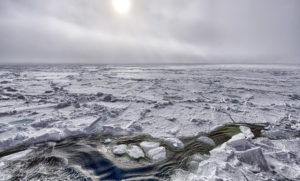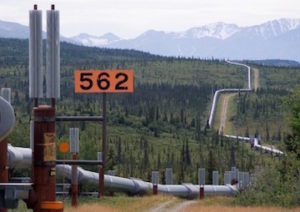Arctic Sea Ice Reaches Lowest Extent for 2013
The amount of sea ice in the Arctic appears to have reached its lowest level in 2013 -- more than last year, but well below the long term average.
By Alex Kirby, Climate News NetworkThis piece first appeared in Climate News Network.
LONDON — Scientists say the sea ice which covers much of the Arctic Ocean appears to have reached its minimum extent for this year.
The fate of the ice year by year is an important indicator of the impact of climate change on the Arctic, where average temperatures are rising twice as fast as elsewhere in the world.
Last year’s ice melt was the the largest on record, but while less ice melted this year the trend is clear: the Arctic is warming and rapidly moving to a stage when it will be free of sea ice in summer.
The announcement of this year’s more modest melting was made, as usual, by scientists at the National Snow and Ice Data Center (NSIDC), based at the University of Colorado Boulder.
They say the extent of the ice fell to 5.10 million square kilometers (1.97 million square miles) on 13 September and has begun its seasonal autumn and winter growth. The record low last year left only 3.41 million sq kms (1.32 million square miles) of ice on 16 September 2012.
Sea ice is frozen ocean water that melts each summer and refreezes each winter. The NSIDC scientists said this year’s higher extent is a temporary reprieve. “While this is a very welcome recovery from last year’s record low, the overall trend is still decidedly downwards,” said the NSIDC’s director, Mark Serreze.
Sensitive indicator
“The pattern we’ve seen so far is an overall downward trend in summer ice extent, punctuated by ups and downs due to natural variability in weather patterns and ocean conditions. We could be looking at summers with essentially no sea ice on the Arctic Ocean only a few decades from now.”
His colleague Julienne Stroeve said this year’s summer was cooler than in the last few years, and that had helped to slow the melting. She said: “Despite the lower temperatures, ice extent still fell well below the long-term average. That’s consistent with the Arctic’s ice cover being thinner than it was a few decades ago.”
It is the dwindling thickness of the sea ice as well as its shrinking extent that helps to show how fast the Arctic is losing ice. It has lost 40% of the sea ice cover since 1980, and 75% of its volume, which also fell to a new low last winter.
Arctic sea ice is recognised as a sensitive climate indicator, and what happens to it has implications for regions far beyond the Arctic itself, because of what scientists call the albedo: as the white ice is replaced by dark water, less heat is reflected away from the Earth and the warming intensifies, affecting climate and temperatures elsewhere.
The NSIDC says its report that the ice has reached its lowest extent for this year is preliminary, because changing winds could push the figure still lower. It plans to update the report in early October.
Your support matters…Independent journalism is under threat and overshadowed by heavily funded mainstream media.
You can help level the playing field. Become a member.
Your tax-deductible contribution keeps us digging beneath the headlines to give you thought-provoking, investigative reporting and analysis that unearths what's really happening- without compromise.
Give today to support our courageous, independent journalists.






You need to be a supporter to comment.
There are currently no responses to this article.
Be the first to respond.